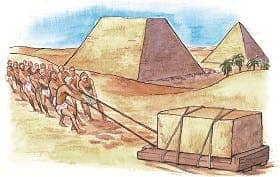Pageviews by Countries 10 Jan 2013 23:30 – 11 Jan 2013 01:29
Pageviews by Countries 10 Jan 2013 01:00 – 11 Jan 2013 00:00 |
Voluntary Temple Slavery in Ancient Egypt 2200 years ago
In the excavations near the ancient temple of Tebtunis archaeologists found a big number of papyri in a garbage dump near the temple that later turned out to be slave contracts with a significant hystorical value. In the text translated from 100 papyruses, an incredible fact was revealed: not only that the slaves voluntarily chose to be slaves for the temple, but also had to pay a monthly fee in order to gain the right to do so.
This finding is reported in the article titled: A Self-Dedication Addressed to Anubis – Divine Protection against Malevolent Forces or Forced Labour? by egyptologist Kim Ryholt of the University of Copenhagen, that appeared in the publication Lotus and Laurel – Studies on Egyptian Language and Religion.
An extract from the ancient texts reads as follows: “I am your servant from this day onwards, and I shall pay 2½ copper-pieces every month as my slave-fee before Soknebtunis, the great god.”
One question that appears when reading these texts is where did the slaves’ money come from ? As Ryholt puts it, “slaves in antiquity, as in modern times, were generally allowed to earn some money on their own.” Although the means through which the slaves generated their income is known largely from speculations, Ryholt mentions one literate slave called Ptolemy, who managed to earn some money by being a “dream interpreter” in his spare time.
After they were discovered in illicit excavations in 1930, the papyri slave contracts were scattered in fragments across Egypt, Europe and the United States, causing researcher Kim Ryholt to spend years in trying to find, translate and analyse these texts. He was the first to analyse collectively over 100 papyri containing such contracts.
The contracts, written in the Demotic script – an ancient Egyptian language, mentioned that some of the slaves also signed up their descendants for serving the temple: “I am your servant with my children and the children of my children”.
![One of the papyri found near the Ancient temple of Tebtunis, located in the northern part, or lower Egypt [Via ] One of the papyri found near the Ancient temple of Tebtunis, located in the northern part, or lower Egypt [Via ]](http://cdn.zmescience.com/wp-content/uploads/2013/01/image_801.jpg)
One of the papyri found near the Ancient temple of Tebtunis, located in the northern part, or lower Egypt [Via sci-news.com]
The author mentions that the motivation for becoming temple slaves would have been mainly out of practical reasons, as it protected the slaves from being forced to work in other more harsh and many times dangerous conditions:
“90 per cent of the people who entered into these slave contracts were unable to name their fathers, although this was normally required. They were presumably children of prostitutes. This is a clear indication that they belonged to the lower classes which the king could subject to forced labor, for example digging canals, if he so desired. However, we know from other contemporary records that temple slaves were exempt from forced labor.”
“Many therefore chose to live as temple slaves because it was the only way of avoiding the harsh and possibly even deadly alternative; the temple was simply the lesser of two evils for these people. And for the temples, this was a lucrative practice that gave them extra resources and money.”
[Via the Nature Blog House of Wisdom]
Voluntary Temple Slavery in Ancient Egypt 2200 years ago is a post from ZME Science. (c) ZME Science - All Rights Reserved.
Thank you for being a subscriber, Download your very own FREE copy of our recently released e-book "Our Incredible World, Like You've Never Seen It Before".

Khalid memotong riben perasmian sebuah jejantas yang dibina oleh kontraktor bumiputra dan siap pada masanya dengan harganya berpatutan
SHAH ALAM: Amalan tender terbuka bagi projek-projek kerajaan negeri yang dipratikkan kerajaan Selangor sejak 2008 telah berjaya melahirkan kontraktor Bumiputera yang kompetitif dan berkualiti.
Menteri Besar, Tan Sri Abdul Khalid Ibrahim berkata, ini sekali gus menolak tohmahan sesetengah pihak yang mendakwa amalan tender terbuka akan menyusahkan kontraktor Bumiputera mendapat projek kerana perlu bersaing dengan kontraktor bukan Bumiputera.
Beliau berkata, tender terbuka dapat memastikan kontraktor yang terpilih berkelayakan dan berkemampuan menyiapkan sesuatu projek dalam tempoh yang ditetapkan berbanding amalan pemberian kontrak secara runding terus yang dipratikkan kerajaan negeri Barisan Nasional sebelum ini yang terdedah kepada penyelewengan.

Khalid melihat pemandangan dari jejantas yang baru siap dibina.
“Tender terbuka membuktikan bahawa amalan yang dipratikkan kerajaan negeri ini betul kerana kita mendapat harga yang rendah tetapi berkualiti. Justeru, tidak betul dakwaan bahawa kontraktor Bumiputera sukar mendapat projek kerajaan menerusi menerusi tender terbuka,” katanya.
Beliau berkata demikian selepas merasmikan Jejantas Pejalan Kaki di Persiaran Kewajipan yang menghubungkan SS13 dengan SS14, Subang Jaya, hari ini.
Jejantas itu disiapkan oleh kontraktor Bumiputera, Aminsa Bina Sdn Bhd. Projek pembinaan dimulakan pada 27 Dis 2011 dan siap sepenuhnya 24 Dis 2012 dengan kos sebanyak RM1.35 juta menggunakan peruntukkan negeri yang disalurkan kepada Jabatan Kerja Raya (JKR) Negeri Selangor di bawah program meningkatkan keselamatan jalan-jalan negeri.
Menteri Besar berkata, beliau berbangga dengan kontraktor Bumiputera itu yang berjaya menyiapkan jejantas berkenaan dalam tempoh yang ditetapkan dengan kos munasabah. Kerajaan Selangor berjaya menjimatkan RM102.2 juta menerusi tender terbuka melibatkan 63 projek sepanjang 2012. Ini menepati konsep ‘value for money’ yang diterapkan dalam pentadbiran dan pengurusan kewangan negeri.
Sementara itu, ADUN Subang Jaya, Hannah Yeoh berkata, pembinaan jejantas itu telah dijanjikan oleh Barisan Nasional pada Pilihan Raya Umum 2008 tetapi tidak dilaksanakan dengan alasan tiada peruntukkan.
“Saya pernah membawa cadangan pembinaan jejantas ini kepada pihak yang berkenaan tetapi alasan diberi ialah tiada peruntukkan dan pembinaannya hanya janji peribadi bekas seorang menteri kabinet,” katanya.
Jejantas ini akan diselenggara JKR Negeri Selangor dan akan dipasang kamera litar tertutup (CCTV) untuk keselamatan pengguna. (Hrkh)


No comments:
Post a Comment